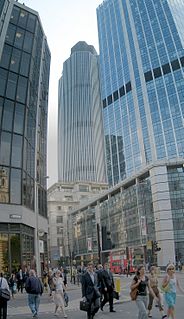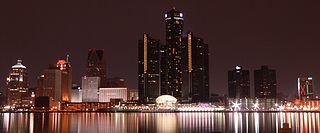Related Research Articles

The Detroit metropolitan area, often referred to as Metro Detroit, is a major metropolitan area in the U.S. State of Michigan, consisting of the city of Detroit and its surrounding area. There are varied definitions of the area, including the official statistical areas designated by the Office of Management and Budget, a federal agency of the United States. Metro Detroit is known for its automotive heritage, arts, entertainment, popular music, and sports. The area includes a variety of natural landscapes, parks, and beaches, with a recreational coastline linking the Great Lakes. Metro Detroit also has one of the largest metropolitan economies in America with seventeen Fortune 500 companies.

The Rust Belt is a region of the United States that experienced industrial decline starting around 1980. The U.S. manufacturing sector as a percentage of the U.S. GDP peaked in 1953 and has been in decline since, impacting certain regions and cities primarily in the Northeast and Midwest regions of the U.S., including Allentown, Buffalo, Cincinnati, Cleveland, Columbus, Toledo, Jersey City, Newark, Pittsburgh, Rochester, and other areas of New Jersey, Ohio, Pennsylvania, and Upstate New York. These regions experienced and, in some cases, are continuing to experience the elimination or outsourcing of manufacturing jobs beginning in the late 20th century. The term "Rust" refers to the impact of deindustrialization, economic decline, population loss, and urban decay on these regions attributable to the shrinking of the once-powerful industrial sector especially including steelmaking, automobile manufacturing, and coal mining. The term gained popularity in the U.S. beginning in the 1980s when it was commonly contrasted with the Sun Belt, which was surging.

Chicago and its suburbs, which together comprise the Chicago Metropolitan Area, is home to 36 Fortune 500 companies and is a transportation and distribution center. Manufacturing, printing, publishing, insurance, transportation, financial trading & services, and food processing also play major roles in the city's economy. The total economic output of Chicago in gross metropolitan product totaled US$770.7 billion in 2020, surpassing the total economic output of Switzerland and making Chicago's gross metropolitan product (GMP) the third largest in the United States, after New York and Los Angeles.

The Liverpool City Region is a combined authority region of England, centred on Liverpool, incorporating the local authority district boroughs of Halton, Knowsley, Sefton, St Helens, and Wirral. The region is in the historic counties of Lancashire and Cheshire. Depending on the definition used, the region's population is between about 1.5 million and 2.3 million.

The economy of New York City encompasses the largest municipal and regional economy in the United States. Anchored by Wall Street in Lower Manhattan, New York City has been characterized as the world's premier financial center. It is home to the New York Stock Exchange (NYSE) and Nasdaq, the world's two largest stock exchanges by both market capitalization and trading activity. In 2012, the New York metropolitan area generated a gross metropolitan product (GMP) of over US$1.33 trillion with a population of 20.3 million people. The combined statistical area produced a GMP of over US$1.55 trillion. Both are ranked first nationally by a wide margin and being roughly equivalent to the GDP of South Korea at less than half its population. The city's economy accounts for most of the economic activity in both the states of New York and New Jersey.

The economy of the Kansas City metropolitan area is anchored by Kansas City, Missouri, which is the largest city in the state and the 37th largest in the United States. The Kansas City metropolitan area is the 27th largest in the United States, based on the United States Census Bureau's 2004 population estimates. The metro's economy is large and influential to its region.

A financial centre (BE), financial center (AE), or financial hub, is a location with a concentration of participants in banking, asset management, insurance or financial markets with venues and supporting services for these activities to take place. Participants can include financial intermediaries, institutional investors, and issuers. Trading activity can take place on venues such as exchanges and involve clearing houses, although many transactions take place over-the-counter (OTC), that is directly between participants. Financial centres usually host companies that offer a wide range of financial services, for example relating to mergers and acquisitions, public offerings, or corporate actions; or which participate in other areas of finance, such as private equity, hedge funds, and reinsurance. Ancillary financial services include rating agencies, as well as provision of related professional services, particularly legal advice and accounting services.

The economy of London is dominated by service industries, particularly financial services and associated professional services, which have strong links with the economy in other parts of the United Kingdom (UK) and internationally. In addition to being the capital city of the United Kingdom, London is one of the world's leading financial centres for international business and commerce and is one of the "command centres" for the global economy.

The economy of Pittsburgh, Pennsylvania is diversified, focused on services, medicine, higher education, tourism, banking, corporate headquarters and high technology. Once the center of the American steel industry, and still known as "The Steel City", today the city of Pittsburgh has no steel mills within its limits, though Pittsburgh-based companies such as US Steel, Ampco Pittsburgh and Allegheny Technologies own several working mills in the Pittsburgh metropolitan area.

The metropolitan area surrounding and including Detroit, Michigan, is a ten-county area with a population of over 5.9 million, a workforce of 2.6 million, and about 347,000 businesses. Detroit's six-county Metropolitan Statistical Area has a population of about 4.3 million, a workforce of about 2.1 million, and a gross metropolitan product of $200.9 billion. Detroit's urban area has a population of 3.9 million. A 2005 PricewaterhouseCoopers study estimated that Detroit's urban area had a gross domestic product of $203 billion.

Chennai, the capital city of the state of Tamil Nadu, India, is the largest industrial and commercial center of South India. Recent estimates of the economy of the Chennai Metropolitan Area is around US$78.6-86 billion, $200 billion with industrial zones; PPP GDP, ranking it from fifth most productive metro area of India, and the third highest by GDP per capita. The metropolitan area doesn't include the nearby industrial zones of Siruseri and Sriperumbudur, due to which these regions' economy doesn't get included in the total economy of Chennai. If these regions are included, the economy of Chennai would be somewhere over $200 billion.
Water supply and sanitation in China is undergoing a massive transition while facing numerous challenges such as rapid urbanization, increasing economic inequality, and the supply of water to rural areas. Water scarcity and pollution also impact access to water.

The Iloilo–Guimaras Metropolitan Area or Metro Iloilo–Guimaras (MIG) is a metropolitan area encompassing the highly urbanized city of Iloilo City, the Regional Agro-Industrial Center of Pavia, the towns of Oton, Leganes, Santa Barbara, Cabatuan, and San Miguel; and the neighboring island province of Guimaras with its five municipalities of Jordan, Buenavista, Nueva Valencia, San Lorenzo, and Sibunag. The towns of Dumangas and Zarraga in the province of Iloilo have also expressed interest in joining in the expansion of the metro.
Located on the Mississippi River, the metropolitan area of Memphis is one of the largest in the Southeastern United States, ranking 42nd in the United States according to the 2010 census. The city has historically been one of the largest shipping hubs in the Mid-South, dating back to the Civil War, when the port was one of the largest on the Mississippi River and served as a shipping hub for the Confederacy.
The Philippines' water supply system dates back to 1946, after the country declared independence. Government agencies, local institutions, non-government organizations, and other corporations are primarily in charge of the operation and administration of water supply and sanitation in the country.
A metropolitan economy refers to the cohesive, naturally evolving concentration of industries, commerce, markets, firms, housing, human capital, infrastructure and other economic elements that are comprised in a particular metropolitan area. Rather than the definition of distinct urban and suburban economies that evolve and function independently, a metropolitan economy encompasses all interdependent jurisdictions of particular regional clusters. This type of economy has all its units functioning together in a trans-boundary landscape that often crosses city, county, state, province, and even national lines. Metropolitan economies expand from the parochial view taken in urban economics which focuses entirely on a city's spatial structure, and broadens it into a metropolitan's spatial and social/economic structure.
In the latter half of the 19th century, private water systems began to be a part of municipal services. As of 2011, over three quarters of US local governments surveyed by the ICMA provide water distribution entirely with public employees. Over two thirds of municipalities provide water treatment publicly, and over half provide sewage collection and treatment publicly. These rates have remained relatively stable over time.
Water supply and sanitation in Vietnam is characterized by challenges and achievements. Among the achievements is a substantial increase in access to water supply and sanitation between 1990 and 2010, nearly universal metering, and increased investment in wastewater treatment since 2007. Among the challenges are continued widespread water pollution, poor service quality, low access to improved sanitation in rural areas, poor sustainability of rural water systems, insufficient cost recovery for urban sanitation, and the declining availability of foreign grant and soft loan funding as the Vietnamese economy grows and donors shift to loan financing. The government also promotes increased cost recovery through tariff revenues and has created autonomous water utilities at the provincial level, but the policy has had mixed success as tariff levels remain low and some utilities have engaged in activities outside their mandate.

The economy of Phoenix was focused during the early years of Phoenix primarily on agriculture and natural resources, dependent mainly on the "5Cs", which were copper, cattle, climate, cotton, and citrus. Since World War II, the Phoenix economy has become diversified.
References
- 1 2 Istrate & Nadeau 2012, p. 36.
- 1 2 Istrate & Nadeau 2012, p. 4.
- 1 2 Global MetroMonitor, The Brookings Institution, 2012, archived from the original on 2013-06-05, retrieved 2013-12-24
- ↑ Istrate & Nadeau 2012, p. 37.